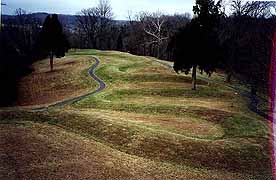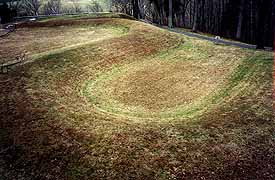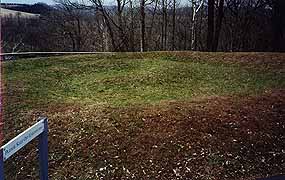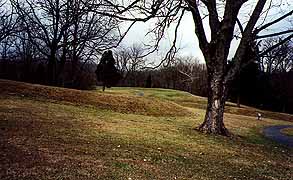American Sabbatical 61: 12/10/96
Columbus and the Serpent
12/10-12... and through the woods.
The weather system which had been chasing us across the midlands was puffing balmy gusts and spittle across
the parking lot outside Frankfort on Wednesday morning. True to
our pledge against road food, I shopped for breakfast-makings
in a local market while Peggy played with Puter. It felt good
to be back on do-it-yourself feedings, and grocery prices. Chowed
and righteous we took flight though Frankfort, another one-industry
state capital. (Bourbon warehouses and banks dominate the government
skyline.. that’s one industry in Kentucky, isn’t it?)
Peggy navigated us cross-lots toward Cin-Cin, for to sense the
hillscapes, and even in December beige the Bluegrass State can
woo you. All we were lacking was an Everly Brothers tape to mood
us in. Instead we did a chorus of Stephen Foster.. My old Kentucky
Home.. as we skedadled up and around the bends. I still dream
of THE AMERICAN ROAD tape, with a signature tune for every environ.
Back in eastern Oklahoma we spun Woody Guthrie, telling dustbowl
tales and singing "Way down yonder in the Indian Nation.. in the
Oklahoma hills where I was born", in Kaintuk we made do with Bela
Fleck’s hillbilly banjo, yeehawing us through the hollers.
Sure is purty country, Ma. Mixed woodlots and pasturage on overlapping
slopes. Ungulates and undulations. Tidy parcels, surrounded with
horse-country fencing, backed on tumbled-trailer ruins. Half the
barns are painted black, and the vertical boarding has gaps you
can see daylight through. Tobacco barns? We didn’t see any other
signs of Kentucky leaf, but Burleigh must grow up somewhere round
here. These black barns would be hot enough in summer to cure
whatever you put in them, and half the paddock fences are black,
too. The rest are mansion-white, and we wondered if there was
some class comment going down.
Cedars are reclaiming some of the old pastures, but there were
plenty of beef still on the munch, and horses frisking, in the
high sixties and thin sunshine. It was with some regret we intersected
with the highroad to Ohio, and we promised to roam the Kentucky
hills again. You can see why Boone and the boys thought this ground
worth fighting over.
We made an end run around Hog Town on the river, although Cincinnati
has undoubtedly improved its odor since the days of Mrs. Trollop.
With the sky shut down and the Ohio greasy-gray, the storied beauty
of this crossing didn’t match up to any of the travelers’ reports
of the 1820’s, either. We caught side-eyed views of the urb's
core towers through notches in the hills, over somber waves of
gain. Then we sneaked out past the exurban limits.
Your intrepid reporters were determined to visit at least one
mound site in the Midwest, if it was the last historic thing they
did this outing, and the great Serpent Mound was only 50 miles
off their route to Columbus. We aimed the Owl eastward to Peebles.
Southern Ohio flattens fast as you leave the hill-and-gully margins
of the great river valley. You quickly run out onto the fat lands
of plenty which made 19th century farmers drop their crowbars
and migrate from New England. Ohio oozes agricultural affluence.
You can smell it. I’ll bet a mouthful of Ohio dirt even tastes
like groceries. But the gentle dips and rises of the farmers’
dream are interrupted here and there by watercourses, and the
topography gets more abrupt. It's in one of these lumpier landscapes
that the Serpent Mound was “discovered”.
| A sinuous dirt mound, 5 feet high, and 15 feet wide, the Serpent
Mound runs along a ridgetop for 1500 feet or so, making the image
of a huge snake.. if you could see it all from any vantage, which
you can’t, even from the contemporary steel and oak tower built
to overlook it. Unless the makers were levitating, this serpent
was for the gods’ eyes only. Fact is, almost nothing is known
about the makers, or their intentions. Nearby grave mounds have
yielded artifacts which connect the site with “Hopewell” and other
prehistoric peoples, but that only defines the lack of knowledge.
So what is this big squiggle on a hill about? |

Serpent from the tower
|

Undulations
|
It was, for us, totally without charge. Unlike at Cahokia or The
Little Bighorn, there was no lingering presence, no voices on
the wind, on this ridgetop. The humid forerunners of a storm fluttered
our clothes as we climbed the tower and walked around the site,
but the only voices were catbirds in the buckeyes below. Here
was a complete mystery, as unresolvable as flamingos in a dooryard,
or painted stones beside a driveway. For all its monumental concept,
this earth serpent is very human-scale in execution. A few of
the boys could conjure up a snake like this in a couple of weeks,
even without a dozer. |
| The big snake uncoils widdershins from east to west, ending its
undulations in a hollow triangle (where the back of a head would
be), followed by an open oval (a swallowed egg?), then a solid
triangular apex (nose). I can imagine ritual birthings and swallowings
in the oval, succeeded by a processional walk uphill along the
spine, spiraling clockwise into the sunrise. Here is a dandy emblem
for our homing in. We, too, spiraled out counter-clockwise, weaving
westward, back and forth across the country, trying to swallow
the essence of the land. But it‘s more than we can take in one
gulp. So we are climbing back uphill. America is still a mystery.
Maybe all we can do to recognize a place is to honor it by making
symbolic gestures, hinting at its essence. Sanctification by symbolic
mimicry. |

Oval
|

Ritual Landscaping
|
Driving from Serpent Mound to Columbus I kept feeling the big
snake in the landforms. The turns in the road, the roll of the
hills, was one grand earth-serpent, with the egg of fertility
in its mouth. The Ohio-snake. And the storm finally caught us,
with intermittent downpours and sideswipe winds. |
But “Why Columbus?”, you ask. Well, how can you discover America
without a Columbus? We also have friends there who offered us
refuge from Midwestern angst, coming or going. Jim and Carol have
been fellow-travelers on the E-train for the last 3 1/2 months,
so I've see them looking over my shoulder as I write. They are
also long-time patrons and dear friends, so I better be careful.
Jim and Carol transplanted from Portland in 1995, returning to
her hometown, where he’s gone into a family business. They’ve
moved into a large brick house in Bexley, an older close-in suburb
to Columbus, and replaced its Midwest cutsie decor with stunning
Maine art, and good taste. Jim says he gets lost in the sameness
of Bexley, trying to find the house, but once inside there’s no
question who lives here. The art we hang up reflects us, and the
art we live with defines home. Peggy’s aunt Margaret always carried
a few symbolic objects which she used to make anywhere home. On
the road we’ve carried some tokens to mark our personal space,
and the Owl’s dash has turned into our home base. Jim and Carol
are serious collectors of contemporary art, and visiting their
new home in Bexley is an adventure in esthetic self-definition.
It’s also a warm and welcoming place in an onrushing storm.
Our hosts, and their son Jeffrey, took us on an auto tour of Bexley,
downtown Columbus, and a resurrected area called Short North,
where we shopped in a covered market and supped in a Mex-ish restaurant.
After Piggot's light shows, Bexley was remarkably ungussied with
seasonal twinkles and cutouts, although the lawns on one street
all had pyramids of light making a corridor of Christmas “trees”.
Our thesis: “the lower the brow, the more the ornamentation,”
seems to hold in central Ohio. Industrial decorations were more
elaborate on corporate edifices, and the state house actually
had a live chorus ornamenting the air. Columbus' annual lighting
ceremony was in full warble as we cruised by, and it made downtown
echo with festivity. We also admired the bronze statue in front
of city hall of a businessman mayor clutching his briefcase. Jim
said that the supporting pillar is covered with quotations to
the effect, “all the average American needs for perfect happiness
is an opportunity for hard work.”
Columbus is booming, we were told, with casual labor starting
at $7.50/hr, and lots of perfect happiness. On a rainy Wednesday
night in December this crossroads of the Midwest seemed vibrant
with seasonal cheer, and we enjoyed a spicy meal with good company.
Jim and Carol and Jeff were just back from scuba diving on the
Great Barrier Reef, and planning another diving trip to the Cayman
Islands, and tropical waters sounded pretty good to us, with the
weatherman threatening a northeaster for the coast of home.
It was raining hard by the time we put rubber to the road on Thursday.
The visibility was virtually nil on the interstate, with big rigs
spuming by and the skyfaucets open. Owl-dancing among behemoths
in a blow makes you swallow hard and hang on. The world squeezes
down to a blur between wiperswipes, and the melodies in your head.
We have been so wide-eyed in the western panorama, so turned outward
to take it in, that this compression in humidity is stifling.
East is so wet!
Ohio begins to bulge and wrinkle as you approach its eastern margin,
although we could only imagine the landscape beyond the drench.
Crossing the Ohio again at Wheeling, West VA, we caught glimpses
of rectilinear boxes bulking up into triple-deckers, climbing
the steep hills of the river city. Thoughts of Polish and Italian
families, or Irish and French Canadians, in other Eastern burgs
made me realize we were wading into familiar turf. And names like
Monongahela and Allegheny brought up floods of memory out of colonial
history and the first Old West. Washington made his name in these
woods, along with Bartram and Mike Fink. Maybe you have to go
EAST to immerse yourself in American history. It certainly gushes
up in your face, this way.
Then we came over an Appalachian ridge into a respite of mild
overcast, and the orderly farms of central Pennsylvania. Determined
not to retrace old steps, we angled across the state through Altoona.
Kits, cats, sacks, and wives, how many were going to Altoona,
as Pogo put it. We were, and did, and plunged into a white fog
along Bald Eagle Creek. Only rare moments of clarity revealed
the long glaciated mountains, whose gentle curves and scooped
valleys seem so old and amiable after the jagged youth of the
West. Then down into the Susquehanna Valley and the rain again.
The local forecasts were for heavy downpours and flooding by morning.
Should we run all night to home, before the big wet? Or hole up
and sleep, and not risk the night ice on the tops? Crossing into
New York State at Binghamton we began to lose our ambition. By
Oneonta we were beat. Let it rain. Goodnight.



